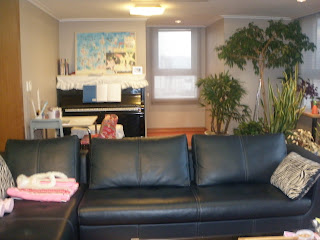Reflective Essay - Highrise: From Korea to Toronto
By Amber Kim
Sam Gosling, the author of a recently released book called “Snoop: What Your Stuff Says about You,” asserts that just by looking at spaces or objects that are related to a specific individual, one can tell the observer about that person’s personality. In my house, my room is full of little ornaments that I like to collect. My little brother’s room is rather messy, but on the whole, it is quite tidy. My parents’ room is spacious and softly lighted. Overall, the place that I call home is cozy, comfortable, and warm. This indeed is my home sweet home, and where my heart is. These everyday observations might seem mundane, but they truly came into a deeper perspective when I came across "HIGHRISE" - a ground breaking "360 degree" documentary available for interactive viewing at Canada's National Film Board website.
In a "highrise" in Toronto, Amchok, a Tibetan refugee, has found a place where he can call “home.” The ongoing documentary project, led by director Katrina Cizek, has continued over the last couple of years, and includes interactive activities for viewers - which serve to shed light on the human condition within highrises around the world. Through this experience, I explored Amchok's life, where he lives in a part of Toronto with a high ratio of immigrants. His life touched me, and it's immediately clear that he enjoys more privileges in Canada than his homeland could provide him. He can play his dranyen (Tibetan lute) whenever he wants to, be with his family, and is free from China’s religious and cultural oppression.
In a "highrise" in Toronto, Amchok, a Tibetan refugee, has found a place where he can call “home.” The ongoing documentary project, led by director Katrina Cizek, has continued over the last couple of years, and includes interactive activities for viewers - which serve to shed light on the human condition within highrises around the world. Through this experience, I explored Amchok's life, where he lives in a part of Toronto with a high ratio of immigrants. His life touched me, and it's immediately clear that he enjoys more privileges in Canada than his homeland could provide him. He can play his dranyen (Tibetan lute) whenever he wants to, be with his family, and is free from China’s religious and cultural oppression.
The apartment that Amchok lives in is uniquely decorated - like a small Tibet placed in Canada. The poster of His Holiness, the Dalai Lama, a flag of Tibet, and seemingly-made-in -Tibet carpets exist proudly in his living room. The clothes Amchok and his family wear, the songs they sing, and the instruments they play are all traces of the Tibetan heritage. Although Amchok lives in a foreign country, he preserves the culture of his origin vividly. In addition, just by looking at Amchok and his family dancing and singing together, their love is clear. Both adults and children seem to enjoy their life fully. They seem to be one perfectly happy family that is satisfied with the present moment. Observing them, I wondered if the common experience of going through the pressure under Chinese control and escaping it might be the thing that peacefully unites and strengthens them. While everyone possesses a strong sense of belonging and love of one’s true home, Amchok appears to go further. But while all seems ideal, and Canada a safe-haven, their are issues confronting Amchok and many other immigrants like him. "Highrise-ation" has continued to progress and create suburbs, which causes segregation in expanding cities like Toronto. Available housing at affordable prices is an issue, and one has to wonder if cultures truly mix in such cases. However, regardless of the social separation, Amchok, a Tibetan, feels happy to have a place to call “home,” which made me think of my own.
I began to ask myself questions. What about Korea's highrises? According to Charlie, my American friend who is currently living in Korea, the highrises in Korea are like “Stalinist era apartment buildings.” I had never thought of them this way, but Charlie did point out the extreme state of uniformity of apartments in Korea. He added that it seems most of the apartments are built in “rows” as if they are strictly for workers to sleep in - when not “working!” He added that Korean homes look isolated and sterile. Perhaps. But I replied by explaining that what should be examined about the highrises in Korea is the interior and the content of them, not just the exterior.
Compared to Western housing, Korean homes are designed more for the utilitarian functions of family, rather than for impressing guests or serving recreation. I remember often seeing the saying “My door is always open” when I lived in America. The culture in the west is definitely more likely to open its doors, and to invite people in. Koreans are different. They perceive “home” as a very private place, not to be easily visited by outsiders. No matter how much a Korean dwelling looks isolated and closed off from the outside, the inside is completely opposite; rather, it is a place where dining, watching television, and chatting occur in the same space, thus more sharing and intimate. Hideaways and privacy are hard to come by, and our culture doesn't stress a need for this. There's an odd mix of exclusion and total inclusion, and the population density is an expression of it. Parking is a good example.
Compared to Western housing, Korean homes are designed more for the utilitarian functions of family, rather than for impressing guests or serving recreation. I remember often seeing the saying “My door is always open” when I lived in America. The culture in the west is definitely more likely to open its doors, and to invite people in. Koreans are different. They perceive “home” as a very private place, not to be easily visited by outsiders. No matter how much a Korean dwelling looks isolated and closed off from the outside, the inside is completely opposite; rather, it is a place where dining, watching television, and chatting occur in the same space, thus more sharing and intimate. Hideaways and privacy are hard to come by, and our culture doesn't stress a need for this. There's an odd mix of exclusion and total inclusion, and the population density is an expression of it. Parking is a good example.
My home in Changwon could be characterized by what I mentioned above about the general Korean highrise, but there is something more special to it. I find the uniqueness of the apartment that I live in to be the relatively small size of the building: my apartment consists of only five floors! Because my home is a low flat, and I live on the fourth floor, when I open the window, I can hear almost everything that passerbys talk about. Others may think that this is little bit disturbing; however, for me, listening to what is going around outside my home is as if I am reading different types of amazing books. I hear young girls gleefully laughing and chatting, drunken people shouting out loud about their discontent toward the world, and lovers enjoying their tug-of-war. The bustling sound outside my window has never been a distraction to me, but an energizer in my life. One more thing that I cannot possibly forget to mention is that a beautiful lake is positioned right in front of my house. This is the second special feature about my place. Nature exists right between the small gaps of the dense forest of buildings. Over seventy percent of Korean land is occupied by mountainous regions. Therefore, instead of building “out”, Koreans are forced to build “up”(although this is not the case with my five-story highrise.) The surrounding nature, a special feature of the place I live, gives me peace and joy.
I recall that no more than 10 years ago, I used to brag about where I lived, to my friends, because Ilived in the 25th floor, possibly the highest at that time. Now that new highrises are built more higher and in large quantities, it would look foolish to brag now. Sometimes, when I think about what a highrise means to people, I am heartbroken. These days, a highrise seems to be considered as a place where people sleep and live, rather than as a place with love and family. Therefore, seeing the case of Amchok truly delighted me, since in Amchok’s highrise, there was love, family, plus music. The time of hastily producing the same shape buildings is not a significant issue at present. Rather, what people ought to feel inside the highrises, and what needs to come across people’s minds when they hear the term “highrise” or “home” are the immediate matters in question to be resolved.





















